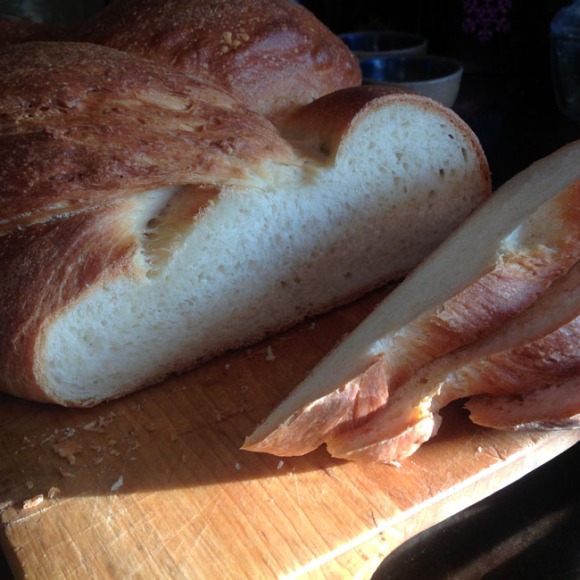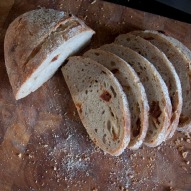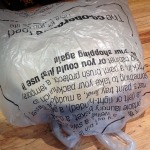Pittas and other flatbreads are so versatile – whether you like to stuff them, wrap them or dip them – and the difference between the pre-packed long-life supermarket versions and freshly cooked bread is night and day. There are essentially two sorts of flatbreads – yeast leavened flatbreads, of which pittas and naan breads are good examples, which tend to be cooked in an oven, and unleavened breads, such as chapatis and tortillas, which are usually cooked on a hotplate or skillet. Different breads vary in their ingredients, but the process for each type is essentially the same.

These are some of the easiest and fastest breads to make – it’s a mystery to me really why anyone ever buys them when they’re so quick, easy and satisfying to make at home. You can even make the dough a day or more ahead of baking – once baked it’s best to eat these breads immediately, as they go stale quickly. If you bake more than you can eat in one go, they’re best frozen as soon as they’re cold. This recipe for pitta breads can easily be adapted to make naan, with the modifications to the ingredients noted below.
To make 12 pittas (takes about 2 hours, including proving and baking time):
- 500g strong bread flour (I use a 75% white, 25% wholemeal mix because I prefer the flavour and texture, but 100% white is fine too. Flatbreads are more forgiving of lower gluten flours, so if you only have plain flour at home you can still attempt this bread, it will just be a little less elastic / chewy) plus extra for dusting / shaping.
- 2 tsp sugar
- 1 tsp salt
- 1 tsp instant dried yeast
- Oil – I use cold pressed rapeseed oil for this (and almost everything), but olive oil would be more traditional
- Water (about 300-400ml)
In a bowl (or bowl mixer fitted with a dough hook) combine all the dry ingredients, about a tablespoon of oil, and mix in enough water to form a nice elastic dough. One of the most common mistakes people make when making bread is not adding enough water to the mix. The best bread comes from a really well-hydrated dough that’s just on the edge of being too wet to work with, under-hydrated dough makes stodgy, heavy bread with poor texture and rise. The more practice you have with this, the easier it will become to judge – I use a little shortcut, which is to add water until I’ve gone a little bit too far, so the dough is starting to become sticky, and then add a spoon or two of extra flour back in just to make it handleable again.
Knead the dough for 5-10 minutes, by hand or in the mixer, until it becomes lovely, smooth and elastic. I oil my countertop for kneading rather than flouring it, as that avoids accidentally incorporating more flour into the dough.
What you do next depends on whether you want the bread today, or not:
- If you want to bake the pittas straight away, oil your ball of dough, return it to the bowl, cover with a clean tea-towel and leave it at room temperature to double in size, which should take an hour and a half or so.
- If you don’t want the pittas until tomorrow (or a little later) oil the dough and cover the bowl with cling film, or put it in a good-sized Tupperware-type container, and put it in the fridge at least overnight. (What you’ve done here is create a batch of ‘fridge dough’, which is really versatile – more on this later. If you’re short of baking yeast at the moment, this is a game changer!).
When you’re ready to bake:
Set your oven to its highest temperature (ideally at least 220C), with a heavy baking sheet or baking stone inside.
Decide how many pittas you want to bake – I tend to take half the dough and divide it into six pieces. Flour your work surface generously for this bit. Form each piece into a tight ball by drawing the edge repeatedly into the centre, and then leave the balls to rest for about 10 minutes, covered with a tea towel.
To shape the breads, you could use a rolling pin (in which case try to roll them out about 5mm thick and in an oval sort of shape). Personally though I can’t see the point, it’s just as easy to stretch them out by hand and I think the texture is better. First, squash the balls down into a thick disk, then slowly stretch them out.

Only stretch the edge, the middle will take care of itself. You’ll find they want to spring back but keep working on them in turn, each time you ‘go around’ you’ll find them willing to stretch a little bit further. Get them to the size and shape you want, around 5mm thick (but this will be a bit variable – it’s fine, but try to avoid going particularly thin as these areas won’t be able to ‘puff’ into the traditional pocket). Cover them again with the tea towel for about 5 minutes.

When the oven is up to temperature, working very quickly, pull out the hot baking sheet or stone. Place each pitta on it, the opposite side up to the way they were on the work surface (having the ‘dry’ upper side down seems to help them bake nicely), and get them back in the top of the very hot oven as quickly as you can. You want to avoid losing any heat if you can.
If everything has gone right, they should puff up in the oven into little ‘pillows’. Once they’ve puffed, you can turn the baking sheet around (particularly important if your oven has hot spots). You want to cook them until the outside of the bread is dry but still soft. Don’t wait for the top to brown, they’ll be crispy by then – they’ll normally have some colour on the bottom where they have been in contact with the baking sheet. Take them out of the oven and cover with a tea towel until serving, just as soon as they’re still warm but not too hot.

They’re perfect for stuffing, dipping in home-made hummus, or enjoying with soups, salads – anything you can think of!
Variation: To make naan –
- Use strong white flour or a 50:50 mix of strong and plain flour (Or 100% plain, see note above).
- Use a mix of half-milk, half water, and add about four tablespoons of plain yoghurt (you’ll need less water/milk as a result).
- You can use a plain-flavoured oil or melted ghee in the dough.
- Once out of the oven, brush with melted ghee or butter while still wet. Mix crushed garlic with this butter for a garlic naan, or fold chopped dried sultanas, figs, or dates and almonds into the dough, before shaping, for a Peshwari-style naan.
- I expect my naan to be a bit bigger than pittas, so I would make six or eight from a full quantity of dough.
More from the Fallback Pantry :: More from the Country Skills Blog >>













 Pick nettles carefully – I wear washing up gloves – selecting the top two or three pairs of leaves only. Nettles are best early in the year, they can get rather tough and coarse flavoured later on. Actually, I tend to pull up a whole batch of nettles – I’m usually weeding – and then pick through them for the nettle tops afterwards. Remove the leaves from the stems, wash them thoroughly, and dry in a salad spinner (keeping your gloves on all the while!). 100g is roughly the amount you get in one of those prepared salad bags.
Pick nettles carefully – I wear washing up gloves – selecting the top two or three pairs of leaves only. Nettles are best early in the year, they can get rather tough and coarse flavoured later on. Actually, I tend to pull up a whole batch of nettles – I’m usually weeding – and then pick through them for the nettle tops afterwards. Remove the leaves from the stems, wash them thoroughly, and dry in a salad spinner (keeping your gloves on all the while!). 100g is roughly the amount you get in one of those prepared salad bags.




















![Fertile egg during candling [Creative Commons licensed image by Graibeard]](https://countryskillsblog.files.wordpress.com/2017/01/img_3158.jpg?w=300&h=300)






 On Christmas morning, I unwrapped an incubator. It’s a Brinsea Octagon Eco 20, with an automatic turning cradle, and I can think of few occasions, going right back to six year old me – perhaps with the exception of the year I received the My Little Pony Castle – when I have been so excited to unwrap a gift and get to work on the contents.
On Christmas morning, I unwrapped an incubator. It’s a Brinsea Octagon Eco 20, with an automatic turning cradle, and I can think of few occasions, going right back to six year old me – perhaps with the exception of the year I received the My Little Pony Castle – when I have been so excited to unwrap a gift and get to work on the contents.























